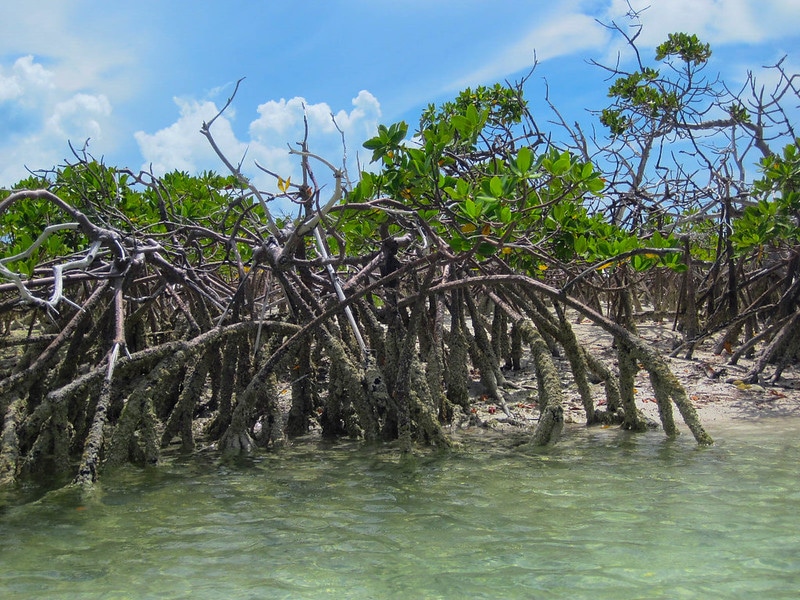According to a new report, global investment in mangrove restoration could return USD$11.8 billion by 2040. The report also outlines the extent to which mangrove forests are underappreciated in their abilities to slow global heating, shield against weather extremes, help halt the runaway extinction of biodiversity and support local economies.
—
What is Happening?
- The report by Earth Security, an environmental finance specialist, called “Financing the Earth’s Assets: The Case for Mangroves as a Nature-based Climate Solution,” details a comprehensive plan for mangrove restoration and carbon sequestration more effectively than today’s “scattered” offset projects.
- It outlines the creation of the first global Municipal Bond Fund to seek nature-based climate adaptation at scale. Such a bond would support the creation of a network of 40 cities around the world, from Miami in Florida to Mongla in Bangladesh, which have been identified by Earth Security for their potential to invest in mangrove restoration as a cost-effective way to adapt to climate change.
- Mangroves are one of the most threatened ecosystems on the planet and are being lost at a rate of 2% per year, faster than coral reefs and allother forest types. The 40 identified cities account for almost 70% of global mangroves still standings, currently storing around three billion tonnes of CO2.
- Mangroves can store carbon up to 400% faster than land-based tropical rainforests and could provide 380 million tonnes of CO2 sequestration by 2040. They also provide breeding grounds for marine biodiversity and 80% of global fish populations depend on healthy mangrove ecosystems.
- Additionally, mangrove forests offer coastal cities a protective shield against extreme weather, which can be up to 50-times more cost-effective than building a cement wall. In 2017, mangroves prevented $1.5 billion in flood damages in Florida, protecting over half a million people during Hurricane Irma. Damages were 25% lower in those Florida counties where mangroves were present.
You might also like: Electric Vehicle Batteries That Fully Charge in 5 Minutes Have Been Produced
Chief Executive and Founder of Earth Security, Alejandro Litovsky, says: “The evidence on the value of nature is clear. But we must move faster and more boldly in investing in nature’s assets; from isolated small projects to a planetary scale. This report is the first of many offering the analytics and new investment pathways to do that. We must look to re-purpose every investment option in the toolbox, while creating more agile global networks that aggregate ecological regeneration investments on a global scale. The mind-boggling economic value of mangroves as a climate solution is a perfect example of why investing in natural assets is the route to align ecological and economic returns.”
As part of its report, Earth Security also makes five recommendations to align global finance with mangrove restoration at scale. These include:
- Create a price for ‘blue carbon’ in voluntary carbon markets- With COP26 on the horizon and a surge in corporate pledges in 2020 to achieve carbon neutrality, demand for and prices of nature-based carbon sequestration look set to increase exponentially. The current price of carbon credits ($10-15 per tonne of CO2) is not high enough to deliver conservation and regeneration. The price must at least double to $29 per tonne of CO2 for regeneration to be possible at the required scale, and quadrupole to $60 to achieve returns forecast at $11.8 billion. The significant value of coastal ecosystems ‘beyond carbon’- from storm protection to sustaining commercial fish- should position blue carbon credits (carbon captured by the world’s ocean and coastal ecosystems) to trade at a price that reflects these values.
- Convene the ‘Mangroves 40 Cities Network’ (M40 Cities) – Flood-related losses suffered by the world’s largest coastal cities are expected to rise to $52 billion per year by 2050. Creating a network of mangrove forests will act as a global safety net that coordinates the collective action of leaders, shares knowledge on regeneration projects and pathways, and facilitates the aggregation of municipal financing. The 40 cities have been chosen due to their proximity to existing mangroves which can be regenerated as a tool to reduce their climate exposure.
- Develop the first global Municipal Bond Fund to finance nature-based climate adaptation – ‘Municipal green bonds’ show significant potential to finance climate adaptation. The municipal bond (muni-bond) market is one of the best recognised segments of global fixed-income markets. The report argues that a municipal bond fund that focuses on nature-based climate adaptation provides the opportunity to pool together different levels of investment risk across developed and emerging markets, reaching the global scale needed for a product to be viable in global fixed income markets.
- Leveraging the benefit of mangroves for a climate financing agreement at COP26 – The report shows that just 25 countries account for over 90% of the mangrove stock and the restorable area. Yet not all of these governments have recognised the power of their mangroves in their Nationally Determined Contributions (NDCs). COP26 will offer a pivotal moment for a discussion of unlocking private financing opportunities and bi-lateral carbon trading agreements. Governments must build mangroves into their NDCs to reap the benefits of climate finance and create cost-effective ways of meeting their climate commitments.
Featured image by: Flickr

















